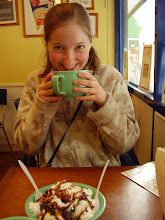
I just saw Eth-Noh-Tec at the Hillsboro Library for part of the Hearing Voices Storytelling festival, and it was amazing. Robert Kikuchi-Yngojo and Nancy Wang are a husband and wife story telling team, some comes from a dance background and he from music so they incorporate much kinesthetic movements and music use of flutes and recorders to their stories, and also vocal music (certain words had a singing quality even if they couldn’t really be said to have been sung).
Tonight they told 6 stories of varying length. The first was a origin story (like the one I’m going to tell tomorrow about rabbit) but this was called “trouble talk” about how human has to work where as no other animal does. Each animal and human character was clearly defined, as well as each scene’s mood. It was a very good story to open with.
The second story was from China about Long Haired Girl and how she saves her village by finding fresh water. The physical gestures were amazing in it, each character having a particular pose to express themselves.
The Third story was a sad one from Japan about a Willow Tree. This one incorporated audience participation with song and movement (like I’ll do tomorrow with Rabbit’s Snow Dance). It was a graceful story and very different from the next from India about an enormous Dog that ate everything (and I mean EVERYTHING) it was really funny, and had the entire audience laughing along. The contrast between these two stories was remarkable.
And the final story they told was called Monkey Moon from Tibet- this was a story in rhyme, and with a particular rhythm to it as well, it would have fit right in a Seuss book.
During question and answer portion Nancy Wang discussed how story was different from theater, in one reason because in theater there is the 4th wall separate the audience from the performer, where as in storytelling the 4th wall extends behind the audience. I had never thought of it that way before. The audience as participating in the story-- I like to think about it like that now. I did notice that with eye contact with these performers- they were always talking directly too audience members. It was very personal.
One difference I noticed between these story tellers and our story telling experiences in residency were the ways that these stories were defiantly memorized-- there were moments of slight improvisation, but for the most part these stories were choreographed and had a precise language to them that certainly added to the performance aspect, but did cause a few “slip-ups” that may not happen in non-memorized pieces.
I’m really excited to see Nancy Wang perform tomorrow at the Beaverton library, and to perform my own story at Family story time. I was so pumped after the performance tonight that I told it to myself out loud in the car on the way home, and then to my father when I got home. He said it was very long, so we’ll see how it goes (now he has me doubting myself, but there has to be a first time for doing a story with out a book to protect me!)
Another thought that struck me during the performance tonight was that none of these stories ended happily ever after. They all came to a fulfilling conclusion but it wasn’t a happy one. It did make me feel better about Rabbit’s Snow dance, which, too, does not end exactly happily. Why do I have it in my head that stories for children have to end happily?
You can check out Eth-Noh-Tec here http://www.ethnohtec.org/
 I lead my second family storytime this last Saturday. I don't feel it went quite as well as the last. I was less practiced with the books, story, and songs, and the audience was much less actively involved, but I think they still had a good time. The theme was strawberries and I told the creation story of strawberries from the book “The First Strawberries: A Cherokee Story” retold by Joseph Bruchac (the same person who retold the Rabbit’s Snow dance from last week). But I found the same story in Pat Nelson’s “Magic Minutes: Quick Read-Alouds for Every Day.” Based on the attention span and interest levels of my audience I cut the story quite a bit (like the entire middle), but I think it was successful. Now I know to feel a bit more comfortable with my stories before telling them.
I lead my second family storytime this last Saturday. I don't feel it went quite as well as the last. I was less practiced with the books, story, and songs, and the audience was much less actively involved, but I think they still had a good time. The theme was strawberries and I told the creation story of strawberries from the book “The First Strawberries: A Cherokee Story” retold by Joseph Bruchac (the same person who retold the Rabbit’s Snow dance from last week). But I found the same story in Pat Nelson’s “Magic Minutes: Quick Read-Alouds for Every Day.” Based on the attention span and interest levels of my audience I cut the story quite a bit (like the entire middle), but I think it was successful. Now I know to feel a bit more comfortable with my stories before telling them.





